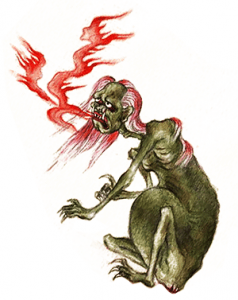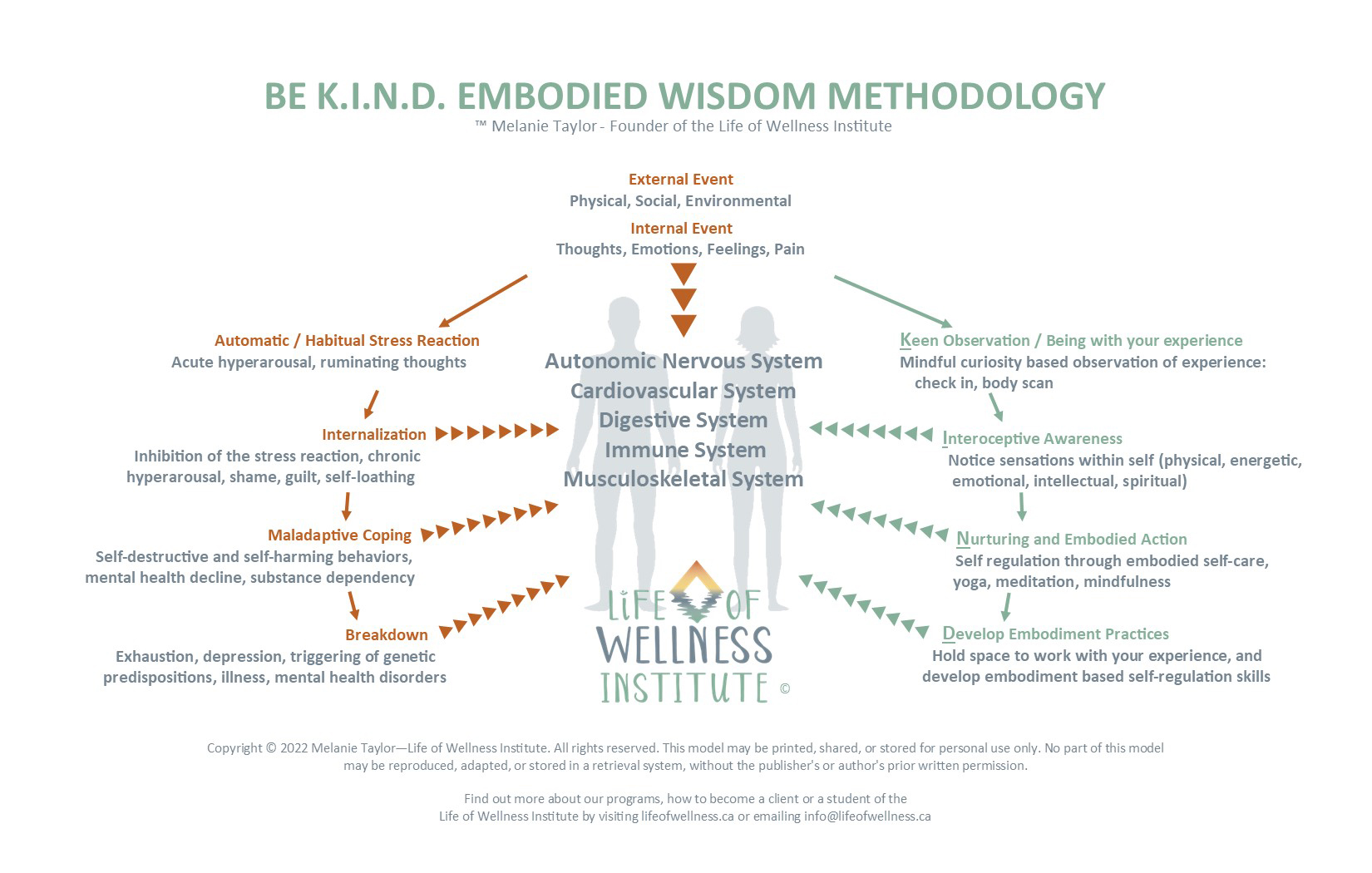
BE K.I.N.D. Embodied Wisdom Methodology (TM)
At the heart of everything we do is a foundation of working with the human experience of being human
As human beings, we are designed to respond to our experiences. Whether internal or external, positive or negative, these experiences move through us, and this cycle plays out thousands of times a day. Over time we develop patterns, and if gone unchecked the pattern itself can become a greater source of our suffering than the reason we developed it in the first place.
There is a saying in yoga, that “the way out is through,” which implies that the way out of our suffering is to go through it. This message can be found all throughout our history. In Dantes Inferno, part of The Divine Comedy of the 12th century, Virgil is escorting dante through Hell, Purgatory and Heaven. While sailing in a one way current they arrive at the gates of hell. Looking in, Dante sees the great horrors inside and is gripped with great fear realising there is no way back. He asks Virgil how they can get out of the terrible situation facing them, Virgil says “the way out is through.” Which has also been translated as “the way out is the way in.” Philosophically it means that when faced with a daunting task the only way through is to face it head on.
At first glance, this can sound rather cold, and reminds me of the saying “suck it up, buttercup.” Which is a loud message in our current society. How many times have you heard the words “no pain, no gain?” Or felt diminished by being told you should be grateful or positive for something that is causing you pain? Frankly, this speaks to a much bigger issue, the lack of compassion and empathy in our society. Which is a can of worms I won’t open here for the sake of time.
But, what if, the message wasn’t telling us we needed to go through hell to get to our destination? What if it was actually an invitation to embodiment?
"The Be K.I.N.D. Embodied Wisdom Methodology, and our courses, are designed to move from a dependance on awareness, and into self-compassionate actions that develop Embodied Wisdom."
Melanie Taylor
Thy why behind the BE K.I.N.D. Embodied Wisdom Methodology
This model was designed as the result of a rather profound moment in my own healing journey. In early 2020, just a month after the Covid 19 Pandemic reached my community I was diagnosed with PTSD. It would take months to realize that it wasn’t the pandemic or even the overwhelming emotions of what felt like a boiling point of tribalism, racism, bigotry, and hate in our world that lead to this moment. As we all stayed home to flatten the curve and protect our health care systems from collapsing, what I was facing was time. Time to be with my emotions and experiences of the current state of our world but also my own internal state.
It seemed like I was slipping into a darkness I couldn’t prevent. Each day seemingly with new symptoms and pain. I was drowning in anxiety, panic attacks, ruminating thoughts, night terrors, and depression. Further complicated by the re-occurance of the disordered thoughts of an eating disorder that had been dormant for more than 25 years.
I had filled my self-regulating toolbox with the methods and means of the eight limbs of yoga, mindfulness based stress reduction, many forms of meditation, interoceptive awareness, somatic awareness, and ayurvedic practices. I had filled my life with what I loved, my family, close friends, hobbies, reading, and travel. But in this moment, when I felt like I needed those all the most, it was not enough. Not even close.
I had spent a lifetime developing awareness, and the belief that awareness was the key to unlock our suffering. This is a foundation of many of the trainings we take in contemplative practices and holistic modalities, such as yoga and mindfulness-based stress reduction. It was a “truth” I had never considered questioning, and heavily relied on. But here I was, drowning into darkness anyway. With doctors and psychologists who praised my self-awareness, and yet all I could feel was shame and self-loathing.
I was aware that I was in pain, I was aware my body was struggling, I was aware that I was emotionally un-regulated. I was aware that I had filled my life with tools that were not able to help. I was filled with awareness, and now I was also filled with the time and stillness to drown in that awareness.
Until this point, I had had used these practices with the knowledge that we all live with stressors from internal and external events in our lives. And that we need stress relieving techniques to prevent the impacts of stress from turning into pain, maladaptive coping strategies, and chronic illness. Which is a foundation of the development of models like MBSR and TM. So, I knew I needed to take action before the discomfort I was feeling turned into something far greater.
The aha moment for me was that the focus on awareness when being mindful, developing personal awareness, interoceptive awareness, somatic awareness and living a life I love, while all essential parts of embodied wisdom, left out two key ingredients compassion and wisdom, and two crucial factors the monkey and disordered mind. Figuring this out allowed me to fully recover and heal my PTSD, eating disorder, and truly learn to care for, tend to, and nurture myself.
“Over-understanding occurs when understanding is an attempt to avoid experiencing feelings or memories.”
Seane Corn
The Disembodied Hungry Ghost
Before we talk about embodiment, let’s talk about the opposite, the hungry ghost. The sanskrit term is “Preta,” which means “departed one,” describing one of the six modes of existence of Buddhism. They are pictured as beings with huge, empty stomachs and pinhole mouths, and necks are so thin they cannot swallow. So, they remain hungry and are riddled with powerful desires they can never really satisfy, leaving them to constantly search outside themselves for the new thing that will satisfy the craving within. Hungry ghosts are characterized by insatiable hunger and craving and are also associated with addiction, obsession, and compulsion.
We each suffer from our own experience of hungry ghost syndrome.
Desires are a very natural part of being human. They are a necessary part of our survival and ability to thrive. However, when our human need is to be safe, to feel a connection, to be fulfilled go unmet, we feel disconnected from others and eagerly search for anything to fill the hollowness inside us. We become fixated and will accept substitutes that can appear to work but only help for a short period. This cycle of maladaptive coping only worsens and creates tremendous pain. Whether perfectionism, a need for approval, an eating disorder, or addiction, it catches and confines us. Like drinking salt water to quench our thirst, the substitutes never satisfy the need.
Then, profoundly sensing our neediness and the compulsion consuming us, we layer on shame and self-hatred. Buddhists call this the second arrow; we are not only caught in the pain of craving but condemning ourselves for it and facing even more suffering. Ultimately, we get stuck in this craving, shame, and addictive loop.
The irony is that the added layer of aversive self-judgment fuels the suffering of the hungry ghost more than anything else I have experienced. The only way to break free and genuinely recover is to resolve the shame and begin working with the deeper inner needs that unfulfilled leave us hollow — safety, connection, and fulfillment.
No matter how gripped by our hungry ghost, which we all experience in our own way, embodiment and self-compassion can guide us back home.

"Embodiment is being with and working with all the sensations, emotions, and experiences life offers."
Catherine Cook-Cottone
Embodiment and Embodied Wisdom
Embodiment or embodied wisdom is not easy to define or describe in words. While I will do my best to describe it for the sake of exploration, please remember that it lives in the body and the heart, not in the words on this page or those spoken in our classrooms.
Embodied wisdom is our ability to maintain a state of relating to ourselves, others, and the world around us that feels connected, compassionate, curious, and creative even within the complexities of life, such as change, struggles, crisis, and intense challenges.
It is more than a thought or idea about a feeling, sensation, or state of being. It is a lived experience in how we sense, feel, see, and relate. It is being able to live and self-regulate in an appropriately relational and interdependent way, with an intention to heal pain and suffering where they arise and help build connection, creativity, and collaboration within, with others, and with the universe.
Embodied wisdom is our capacity to appropriately care for, tend to, and nurture ourselves. While connected with the wisdom of our koshas (the physical, energetic, emotional, intellectual, and blissful layers of self), our physiology (nervous system, organs, anatomy, cells, biological compounds, and how they all interact to make life possible), our psychology (emotions, assumptions, beliefs), and sociology (social connection, spiritual connection, self-identity within our society), within ourselves, our lives, our relationships, our communities, our environment, and the universe.
As we learned from the hungry ghost, what we seek is not external, and searching there will always cause more pain and suffering. It will never be found in financial or social status, a body shape or size, or the car you drive. This is why developing embodied wisdom is the key to an intelligent, nurturing, and sustainable relationship with ourselves, and the key to inner peace, a sense of purpose, and the feeling of belonging.
Embodied wisdom is also the key to transforming our world into one that works for everyone. With our focus no longer on productivity, success, and profit that is so entrenched in our society, but transformed into a focus on recalibrating our existing systems through healing, repairing, regenerating, and resolving hurt, pain, and suffering. This way of tending to our health, relational health, and community health can transform our current global system, currently focused on extractive, exploitative, and accumulative transactions, into one that is genuinely regenerative, relational, sustainable, and just.
“The body speaks clearly to those who listen.”
Pat Ogden
Living with Embodied Wisdom
In our everyday lives, we are presented with external (physical, social, or environmental) and internal (thoughts, emotions, feelings, and pain) events, such as change, crisis, or challenges with life, relationships, and the outside world. When these occur, we have the resources to first interoceptively sense it, feel into (affectively/emotionally), to make sense of (cognitively) what is occurring before we engage in action (behaviors.)
Before we choose what to say or do next, we explore where there are differences between our external and internal reality with the awareness that almost all pain, suffering, and failure – including the seemingly intractable problems – are the result of the mismatch between what occurs in the external and the internal experience. We seek to feel into and comprehend relational disruptions before determining how and when it is best to intervene.
Due to developing embodied wisdom, and as a result of how we care for ourselves, we have the insight, energy, and mindset to explore changing dynamics of our environments, how they relate to us, our relationships, and the world around us. This means we sense and comprehend changes in the world and systems we live within, such as social structures, cultural codes, economic systems, and the complexity of relationships in groups, organizations, and communities.
We have the resources, inclination, and discernment to explore changing environments within ourselves and how they relate to our external environment. Such as:
- State of mind, psychological attention and fixations, memories, and imaginations.
- Emotional granularity, recognizing of triggered wounds, and emotional regulation.
- Nervous system states, interoceptive activation and valence, heart rate and heart rate variability, stress levels, and hormones.
- Cognitive bias: such as confirmation bias, hindsight bias, self-serving bias, anchoring bias, availability bias, the framing effect, inattentional blindness, assumptions.
- Implicit biases: such as being more receptive based on race, ethnicity, age, gender, sexual identity, sexual orientation, and ability
We intuitively and curiously consider what is best for ourselves, others, and the world around us through a holistic, integral, and nuanced view, able to analyze the segments of something while seeking its wholeness. While staying grounded in our wholeness and expansiveness, lovingly aware of body and mind, focusing on the health of systems within, and surrounding us, without diminishing or dismissing the suffering within them.
Without blame, shame, or narcissistic grandeur, we can engage in self-study, self-discipline, and transformation of problems or challenges within our body or mind. Facing the problems and challenges, we are presented with embodied wisdom while open to discovery. And with our collective humanity in our hearts, continuously looking to contribute and serve the whole.

We want you to use this model as a personal guide for creating a new way forward. Click here to download a PDF version for your reference.
We appreciate that you may want to reference and share our work, our content, and our material. You can do so provided you cite us as the original source and notify us through a social media tag or email.
